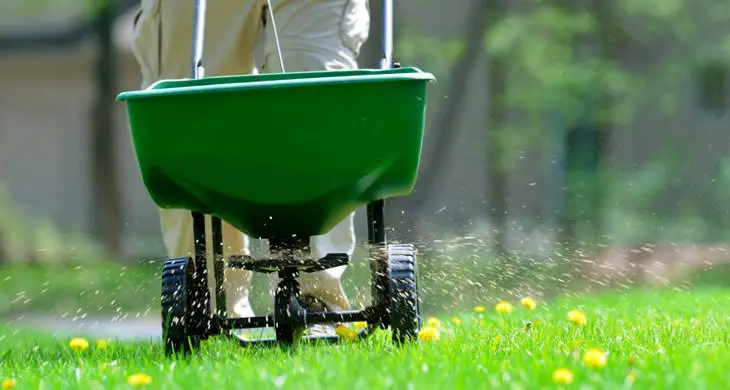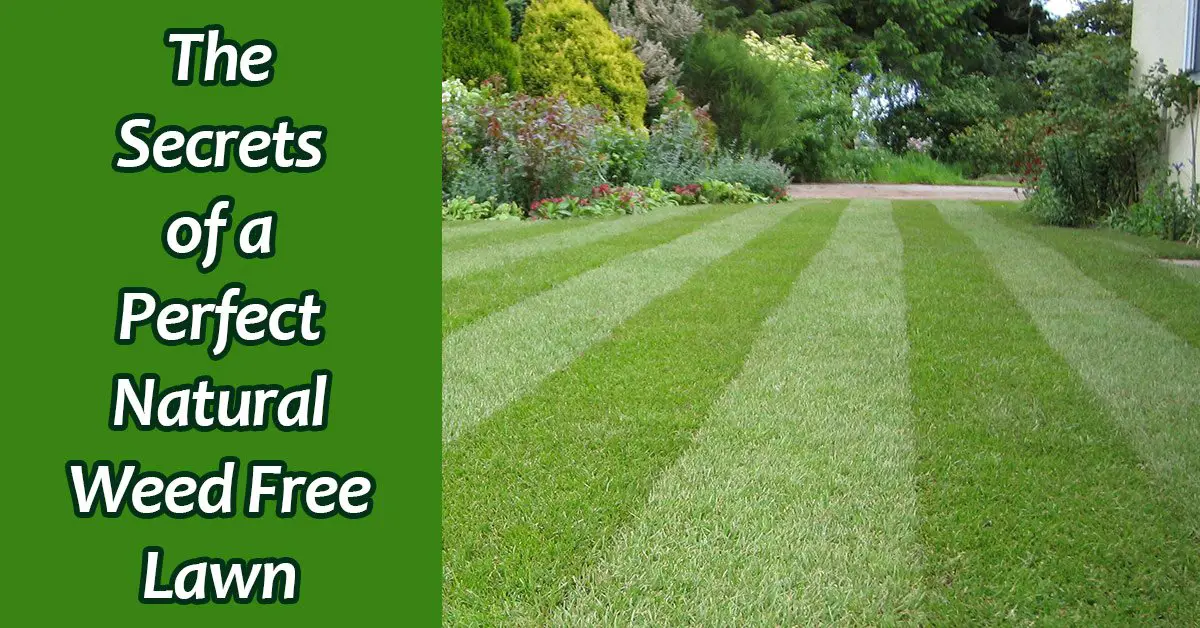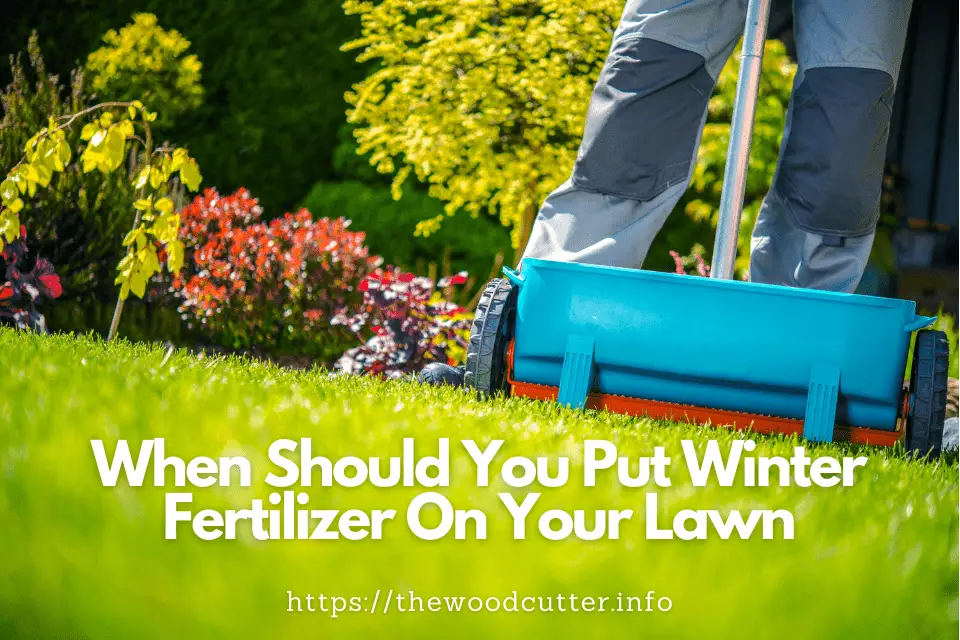Best Time To Fertilize Lawn
Fertilizing in the morning allows the soil to take in the most nutrients, soak in the morning dew and take advantage of cooler temperatures. Thats the best time. Do not apply fertilizer on an abnormally hot day, not even in the morning. Wait until the weather cools back down to a normal temperature.
You can mow anytime after fertilizing with a granular treatment. With a liquid treatment, wait a day or two.
Shutterstock
Uneven Excessive Application Of Herbicides
Granular weed and feed products are applied to the entire lawn, not merely to areas of weeds, which results in herbicides being applied where they are not needed. The mixture of fertilizer and herbicide is incompatible because one ingredient should be applied to the entire lawn, and one is intended for problem spots. In most lawns, broadleaf weeds like dandelions usually occupy less than five or 10 per cent of the area.
Gary Fish, an environmental specialist at the Maine Board of Pesticide Control, who used to work with Chemlawn before it merged with Tru Green, believes the combined weed n feed products, whether for pre-emergent fertilizer or for weeds, are unnecessary and harmful to the environment. Fish said weed n feed products use 20 to 30 times more pesticide than is needed.
When we give lawns more food than they need, the excess fertilizers end up in the water because plants simply cant absorb as much as we think they want.
How Often Should You Fertilize Your Lawn
Fertilizer is a convenient and helpful tool that is beneficial to homeowners and their lawns. It helps speed up the growth process while keeping your grass healthy, making things easier for you. However, it can do more harm than good if not used properly. Knowing how often you should fertilize can prevent you from overdoing or under-doing it and ending up with poor results and prolonging the process. Chorbie is here to help you fertilize effectively, making your lawn beautiful.
You May Like: When Should You Aerate Your Lawn In Georgia
Winter Lawn Care Advice: February
There is not much to be done to the lawn in February as the weather tends to be very cold still. Continue to stay off the grass if you can, especially if there has been a frost, as walking on your lawn when theres been a frost can damage it. Continue or begin to tackle any moss problems by applying a suitable treatment to your lawn. This can discourage the moss issue and also any lawn disease problems. It would be worth investing in a good quality spreader or sprayer which can be used to apply treatments to your lawn. With March just around the corner now might be a good time to get the mower out and check it all works well. It may well need a service. We’ve got a few more Winter Lawn Care Tips too.
Why Use Weed ‘n’ Feed

From morning dew to midday warmth, theres nothing like the feel of lush green grass under bare feet. Big or small, front or back garden, your lawn is there to be played on, relaxed on, and enjoyed. But when weeds start to take hold, it can change how you use your grass. Scratchy, rough broad weeds and a dry patchy lawn change it from a place of escape to somewhere to be avoided.
We get it time is tight. You dont want to add anything more to your to-do list. Which is why Weed n Feed is ideal all you need to do is spray or sprinkle it on your lawn every six weeks to notice visible weed control of broadleaf weeds. The iron in the granular formula has a salt-burn effect, getting rid of flatweeds while leaving vertical blades of grass standing tall and green. The hose-on concentrates contain 2 different herbicides to provide broad spectrum weed control. Its built-in fertiliser contains nitrogen to encourage lush green leaf growth, and iron to promote a rich deep green colour.
Recommended Reading: Who Manufactures Cub Cadet
Tips For Success With Your Weed And Feed Application
Even when you choose the perfect time and weather for a weed and feed treatment, things can still go wrong. You can increase the chance of a successful application by following these tips:
- Your grass should be between 3 to 5 inches tall.
- Use a sprinkler to moisten your lawn lightly before applying the weed and feed treatment.
- Dont water your lawn for 48 hours using weed and feed.
- Follow the manufacturers instructions to avoid over treating your lawn.
Do you want your lawn to look outstanding this year? Why not work with the landscaping experts at Green Acres Landscape Inc. Green Acres Landscape has been helping home and business owners create beautiful outdoor spaces since 1992. Whether you need routine landscaping maintenance or help with a new project, Green Acres Landscape can help. Call 503-399-8066 or book an appointment online.
Spring Lawn Care Advice: April
As spring continues the weather is more likely to be consistently warmer. Be aware that the odd frost can still fall so dont cut the grass too short and avoid walking on the lawn if there has been a frost. You will probably find that you will be mowing the lawn more frequently now too. April is the time to apply a fertiliser to your lawn to encourage growth particularly if youve been treating a moss problem which can leave your lawn looking bare. If you do have some bare patches, now is the time to sow some grass seed. Being rigorous with lawn care during the spring will yield great results in the summer. Here is our selection of spreaders which will help you spread seed, fertiliser or herbicides quickly and efficiently.
Don’t Miss: How To Kill Wild Violet Weeds In Lawn
How To Apply Weed And Feed Products
Its important to apply the weed and feed correctly so that its effective. Generally, you should:
- Make sure the lawn is at a normal height .
- Wait two to four days after mowing before you apply the product. That protects the grass. The weeds are active, so its going to kill them efficiently.
- Use a spreader or a liquid sprayer. This depends on the product you choose.
- Follow directions and only add as much as you should. Spread it uniformly across the lawn.
Winter Lawn Care Advice: December
In terms of lawn care your routine, things will really slow down around now. Frosts are more likely to fall and there may even be snow so try to avoid walking on your lawn as this can damage it. When the lawn is not frozen, or very wet, continue to keep it free from fallen leaves and other debris to reduce the risk of lawn diseases. Although the grass is hardly growing, there is still plenty to do around the garden like clean out your pots, tidy up the greenhouse and planting hardy seedlings for next year. It may be worth thinking about a greenhouse heater to keep your indoor pots and seedlings warm over the winter.
Also Check: How To Kill Creeping Charlie In Lawn
Winter Lawn Care Advice: November
You may still need to mow your lawn during November, if this is the case ensure your mower is set to one of its highest cutting settings. As the winter is almost up on us, now is a good time to give your mower blade a good clean or to give the whole mower a service before putting it to bed until the spring. Continue to remove any fallen leaves from the lawn to reduce the risk of disease. If any early frosts fall remember not to walk on the lawn to reduce the risk of damaging it. Take a look at our Gardening in November article for more detailed advice.
When To Schedule Lawn Maintenance
It is important to schedule your lawn care maintenance during times that match the life cycle of the turfgrass.
- Do not add fertilizer too early in the spring. This may encourage the grass to grow during a time when it should be slow or dormant.
- Do not spray to control weeds when temperatures are warm. This increases the likelihood of damaging the lawn.
- Do not fertilize in hot mid-summer months. This can cause irreversible damage to your lawn.
- Crabgrass doesn’t develop until late spring or early summer, so don’t apply herbicide used to prevent pre-emerging crabgrass in the fall.
See Water-saving strategies for home lawns for information on how and when to water.
Read Also: Violet Weeds
Dont Waste Your Time Or Money
Applying fertilizer at the correct time is essential for getting the most out of it. This also saves plenty of time and money without blowing it on trial and run errors. Keep in mind, overfeeding is a real thing and can be dangerous for the environment. On top of that it also hinders growth in your lawn, so be careful.
Weed And Feed: The Common Types

Its a good idea to know what kind of weed killers you can find out there. In general, there are two major types of weed killers in the market:
Pre-emergent weed exterminators
These types of weed killers prevent the biological growth of weeds. You need to pre-apply this before the rainy season starts.
Post-emergent weed exterminators
Exterminators of such kind are applicable during the weed growth. The usual application time is at the end of the year. Also, you may need to apply them multiple times.
Read Also: How To Kill Creeping Charlie In Lawn
How Do I Know How Often To Fertilize Lawns
If you fertilize too little you wont feed your lawn with the nutrients it needs, and it may turn brittle and yellow. Apply too much fertilizer too early or late, and you can burn the blades.
Most lawns will do fine with fertilizing one or two times a year, in the early spring and the fall, but this depends on the type of lawn you have. Some people do it four times per year. In this case, we recommend keeping in mind the big holidays to do it: around Easter, Memorial Day, Labor Day, and Halloween.
Depending on your lawn, you can fertilize up to once every four or five weeks if using synthetic fertilizers. If you have a slow-release organic fertilizer, you can space out the applications for eight to 10 weeks.
Avoid fertilizing in the peak temperatures of the summer. The heat and blazing sun together with the fertilizers can damage your grass.
Winter Lawn Care Advice: January
January can be quiet in the garden. If there is a frost avoid walking on your lawn as this can damage the grass leaving it vunerable to lawn diseases and other problems. When the weather is fine brush away debris or leaves that have fallen on the grass. Why not take a look at our winter lawn care tips too. If you have a moss problem now can be a good time to apply a lawn treatment, have a look at our range of spreaders. This can help your lawn look better by the time the spring comes around!
You May Like: Zero Turn Mowers For Sale Lowes
Caring For Lawns After Application
A Complete Guide To Lawn And Grass Feeding
Its a fact that lawns benefit from regular feeding. Without extra nutrients, the grass soon uses up plant food reserves in the soil and then turns pale and thin.
Without food to develop side shoots and thickness, the lawn seed is also open to invasion by weed seeds and moss, that thrive in low nutrient conditions. On the other hand, a regular supply of supplementary food makes your lawn thick and green.
This photograph on the right shows the difference feeding your lawn can make. On the left section the lawn has been fed with a granular lawn food, on the right section nothing extra has been applied. As you can see, the fed section of lawn is much greener and healthier looking.
There a few types of lawn feed, so you may be a little confused about what to look out for when buying online.
But dont fret below are the descriptions and properties of the types of lawn feeds, including the specific benefits of each.
Also Check: Who Sells Ariens Lawn Mowers
When Is It Too Late To Use Weed And Feed
It is generally considered too late at the end of fall. After this, if you are in a cold area, winter will start to take hold and the weed killer element will have nothing to work upon. It works when the weeds are actively growing, or before they sprout, depending upon whether you have a pre emergent or post emergent type.
How Much Is Too Much
This is something that you have to figure on your own as each lawn is different. There are a few things that you should consider when applying weed and feed to your lawn:
- Ingredients present in the weed and feed
- Frequency of weed growth in your lawn
- Soil type and texture
To determine the right amount of weed and feed for your lawn, you need to know your lawn area, the kind of product you are using, and the application frequency. Otherwise, you can wait for the lawn to discolor and realize that you are probably putting too much product.
Recommended Reading: How Often Should I Water My Lawn In Colorado
The Weed Control Timing Chart
Herbicides may be almost completely ineffective if applied at the wrong time of year. There is an optimum time frame to apply an herbicide to each weed. In most cases, this time is early in the weeds life cycle, but in some cases, herbicides should be applied during a different growth stage. Generally, weeds should be actively growing when an herbicide is applied. In certain instances, only a pre-emergent herbicide may provide effective control. Remembering when to apply herbicides for the many different weeds can be a challenge. The herbicide label provides definitive information concerning the turf growth stage, time of day, and weather conditions when the product may be applied, but this simple chart can help in making a plan for the timing of lawn weed control.
The Lawn Weed Control Timing Chart was developed to help remove confusion and guesswork when determining the recommended time of year to control various weeds in lawns. The chart is arranged with a list of common weeds in rows on the left, and months of the year in columns on the top of the chart. The row for each weed listed has a colored bar in the row, indicating the time frame when the weed may be most effectively controlled. Green bars indicate application time ranges for post-emergent herbicides , and goldenrod bars indicate application time ranges for pre-emergent herbicides.
Why Should You Apply Weed And Feed

Applying weed and feed on your lawn will make it greener and richer in color after a week. If there are any moss, it will start to turn black and will eventually die, which you can then raked out after a maximum of 10 days.
Weeds, on the other hand, will vigorously grow but then will become distorted and eventually die as well. The maximum control of weed can be achieved in a couple of weeks or so. Now, if your lawn is infested badly by weeds, then applying weed and feed every 6 weeks will help.
These are the tips on when to apply weed and feed to ensure that you will effectively eliminate the weeds on your lawn.
Do not over apply to avoid problems as well, since overly using it can cause the grass to be affected as well and not just the weeds.
Also Check: How Much Should I Pay A Teenager To Mow My Lawn
Why You Should Water In The Weed And Feed
Many products state clearly on the label to water in the product immediately afterward. Its best to follow the directions.
Generally, this means that there is a special ingredient in the product. It requires water for it to go into the soil and get absorbed by the plant roots. Until its watered, it cant work correctly.
Theres another reason to water in the product. The ingredients get washed down under the foliage of the grass. That means you dont get it on your shoes when you walk on it.
